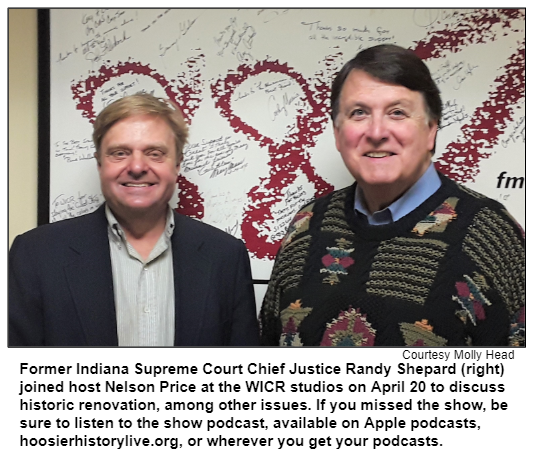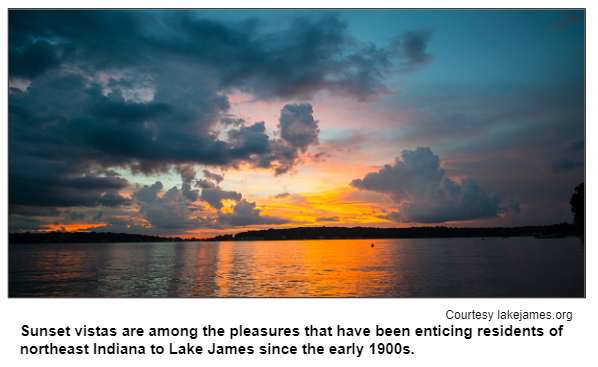
Saturdays, noon to 1 p.m. ET on WICR 88.7 FM.
Or listen live from anywhere on WICR Online!
Our call-in number during the show: (317) 788-3314
April 27, 2019
A tour guide's fun facts about Indy 500 and pageantry
Who is the only person to participate, as a musician at an Indiana high school, in the Spectacle of the Bands at the Indianapolis Motor Speedway, then eventually compete as a race driver in the Indianapolis 500?
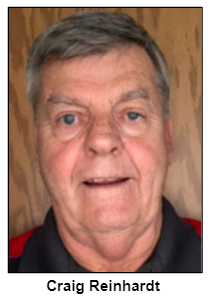
And who has been the oldest winning driver in Indy 500 history?
The answers are among the fun facts about "The Greatest Spectacle in Racing" and its pageantry - including the 500 Festival Parade - that Nelson's studio guest will share during our show. A tour guide at the racetrack, James Craig Reinhardt (who is known as "Craig") retired from his job as a Tampa businessman to move to the town of Speedway and indulge his lifelong dream of being affiliated with the world-famous race.
Craig is the author of two new books, both published by IU Press: The Winning Cars of the Indianapolis 500 and The Indianapolis 500: Inside the Greatest Spectacle in Racing.
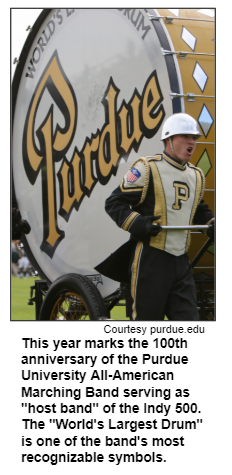
Craig says his interest in the Indy 500 was sparked during the early 1950s when his father took him to the race, which kicked off a string of more than a dozen such visits.
"I can still remember sleeping in our red and white Pontiac Star Chief on West 16th Street across from the main gate the night before a race," he says.
As a tour guide since 2014, he has kept notes about questions that the public frequently asks about the race and its storied venue, which led him to compile the answers in his two books.
According to The Winning Cars of the Indianapolis 500, the oldest champion driver since the first Indy 500 in 1911 was Al Unser Sr., who took the checkered flag in 1987 when he was 47 years and 360 days old.
According to The Indianapolis 500: Inside the Greatest Spectacle in Racing, the only person to be both a Spectacle of the Bands musician and a race driver was Johnny Parsons, who drove 12 times in the Indy 500 between 1974 and 1996. Before his racing career, Parsons was a trumpet player in the marching band at Scecina Memorial High School and participated in the pre-race musical festivities. (History fact: Parsons is the son of Johnnie Parsons, who won the Indy 500 in 1950.
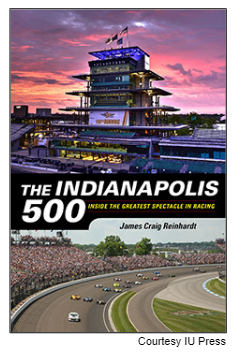
The well-known promotional phrase "Greatest Spectacle in Racing" dates to the mid-1950s. During our show, Craig will describe its origin, as well as the annual involvement in pre-race festivities and the 500 Festival Parade of the Gordon Pipers, a Scottish/Celtic bagpipe band.
Some other fun facts from Craig's books:
- Although the starting field of the Indy 500 has almost always consisted of 33 cars for several decades, the number fluctuated in earlier eras. In the 1933 race, there were 42 cars, the largest starting field ever.
- The youngest victorious driver has been Troy Ruttman, who was just 22 years old when he won the race in 1952.
- For 37 consecutive years beginning in 1950, a spectator from Arizona was the first in line when the IMS gates opened for practice in early May.
People are talking about Hoosier History Live!
We hate to brag, but here's what a recent guest on the show had to say about us:
"Hoosier History Live has amassed a vast library of content over the years, both with the show audio and newsletter material. I believe that the Hoosier History Live content has great value to sponsors and advertisers via widespread online distribution. Nowhere else do you find the fresh new material each week, the depth of stories, the richness of detail, and the long-term consistency."
- John McDonald, CEO, ClearObject in Fishers, Indiana, Inc. Magazine’s fastest-growing IT company in Indiana for 2014, 2015, 2016 and 2017.
Roadtrip: Old buildings, historic bridges and a cool diner in Plainfield
Guest Roadtripper and film historian Eric Grayson suggests a visit to the town of Plainfield, just west of Indianapolis along the Old National Road in Hendricks County.

As a film historian, Eric is quick to point out Plainfield's old Village West Theater, which opened in 1927 as the Prewitt Theater. This endangered landmark is one of the few surviving theaters on the National Road; it is currently not open to the public, but hopes are high that it can be restored and find a new way to serve the community!
After checking out downtown Plainfield, Eric suggests a walk on the trails along White Lick Creek, which crosses Main Street (US40) just west of the Village West Theater. Among the scenery on the trails you'll find lovely historic bridges, including a very large steel truss bridge. Many of them are repurposed, having been moved to the area to become pedestrian bridges in the town's trails network.
And if your stroll along White Lick Creek trails helps you work up an appetite for lunch, you can't beat The Oasis Diner, another historic gem: this 1950s roadside diner was moved four miles west on US 40 a few years ago and restored to its classic 1954 look.
Old buildings, historic bridges and lunch at a 1950s diner; sounds like the perfect Roadtrip for Hoosier History Live fans!
History Mystery
A well-known former racecar driver has the dubious distinction of leading for the most laps during Indy 500 races over the course of his career without ever winning.
According to The Winning Cars of the Indianapolis 500 by our guest James Craig Reinhardt, he led for a total of 431 laps in a nearly 20-year driving career at the Speedway that began in 1984.
Question: Who is the mystery Indy 500 driver who lead for the most laps, but never won?
Hint: He continues to be a high-profile figure as the owner of an IndyCar racing team.
Please do not call in to the show until you hear Nelson pose the question on the air, and please do not try to win if you have won any other prize on WICR during the last two months. You must be willing to give your first name to our engineer, you must answer the question correctly on the air and you must be willing to give your mailing address to our engineer so we can mail the prize pack to you. This week's prize: a pair of tickets to the 2019 Indiana Wine Fair at Story Inn in Brown County on May 11, courtesy of Story Inn.
Please email molly@hoosierhistorylive.org if your business or organization would like to offer History Mystery prizes.
Talking historic renovation with Chief Justice Randy Shepard
Nelson Price, host and historian
Molly Head, producer/project manager, (317) 927-9101
Michael Armbruster, associate producer
Cheryl Lamb, administrative manager
Richard Sullivan, senior tech consultant
Pam Fraizer, graphic designer
Garry Chilluffo, special events consultant
Please tell our sponsors that you appreciate their support!

 Acknowledgments to Monomedia, Visit Indy, WICR-FM, Fraizer Designs, Heritage Photo & Research Services, Henri Pensis, Aaron Duvall, Chloe Tyson, and many other individuals and organizations. We are independently produced and are self-supporting through organizational sponsorship and through individual contribution at the yellow button on our newsletter or website. For organizational sponsorship, which includes logos, links, and voiced credits in the show, contact Molly Head at (317) 927-9101 or email her at molly@hoosierhistorylive.org. Our media reach continues to grow via podcasting and iTunes.
Acknowledgments to Monomedia, Visit Indy, WICR-FM, Fraizer Designs, Heritage Photo & Research Services, Henri Pensis, Aaron Duvall, Chloe Tyson, and many other individuals and organizations. We are independently produced and are self-supporting through organizational sponsorship and through individual contribution at the yellow button on our newsletter or website. For organizational sponsorship, which includes logos, links, and voiced credits in the show, contact Molly Head at (317) 927-9101 or email her at molly@hoosierhistorylive.org. Our media reach continues to grow via podcasting and iTunes.
Thank you!
We'd like to thank the following recent, new and renewal contributors whose donations help make this show possible!
- Perry and Melanie Hammock
- Jim and Bonnie Carter
- Barbara and Michael Homoya
- Noraleen Young
- Barbara Wellnitz
- Phil and Pam Brooks
- Russ Pulliam
- Roz Wolen
- Marion Wolen
May 4, 2019 - coming up
Lakes, lakes and more northern Indiana lakes
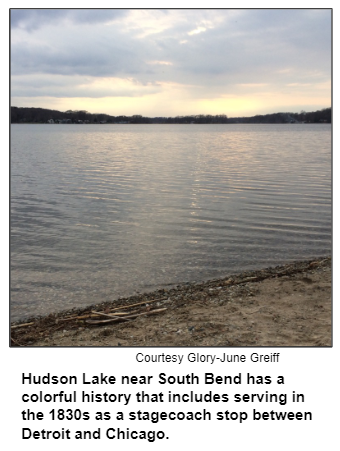
In LaPorte County, Hudson Lake has a colorful history that includes, during the 1830s, a cluster of cabins and shops on its shores that served as a stagecoach stop between nascent Detroit and Chicago.
Today, Olin Lake in LaGrange County has the largest undeveloped shoreline of all of Indiana's natural lakes.
They are among the lakes in northern Indiana that we will explore during a show with a special format. Nelson's guests will be a series of "lake correspondents" who will phone in with reports about the heritage of natural lakes in northern Indiana.
As we noted during a show last summer about our state's two largest natural lakes - Lake Wawasee and Lake Maxinkuckee - most of the lakes in northern Indiana have glacial origins. Large lakes in southern Indiana, including Lake Monroe, are man-made.
Our lake correspondents will include:
- Jim Somers and Flaim Cupp, co-authors of the 2011 book A History of Lake James; both of their families are long-term property owners at the lake, which covers 1,229 acres and reaches a depth of 88 feet. They report that of about 800 cottages on Lake James today, about one-fourth are owned by year-round residents like Jim and Flaim.
Public historian Glory-June Greiff, who grew up at Hudson Lake. "LaPorte County is so lake-filled that you're bound to run into one just wandering the roads," she notes. "The county seat of LaPorte has at least five within its city limits."
- And botanist Michael Homoya, who recently retired from the Indiana Department of Natural Resources. He will share insights about Olin Lake, which has a shoreline of about 2 miles in length. "Interesting wetlands border the lake, including a 'fen'," Michael reports, adding that a fen is a "natural community that is saturated with groundwater seepage flowing in a diffuse matter."
On the shore of Lake James, Pokagon State Park was established as an Indiana State Park in the 1920s, taking its name from illustrious leaders of the Potawatomi, a Native American tribe that once fished, hunted and lived across northern Indiana. During the 1920s, '30s and '40s, Big Band music attracted thousands of patrons to Lake James, according to Jim and Flaim. Motorboat racing has been a popular attraction for generations of lake-goers.
At Hudson Lake, the 1830s cluster of cabins was called Lakeport and, according to Glory-June, "vied unsuccessfully to become the county seat." She reports that 100 years later, Hudson Lake was a "happening place" again, with a casino (featuring performers such as jazz great Bix Beiderbecke) adjacent to the tracks of the South Shore Railroad running between South Bend and Chicago.
"Today," she says, "Hudson Lake is quiet, basking in its history."
© 2019 Hoosier History Live. All rights reserved.
|



